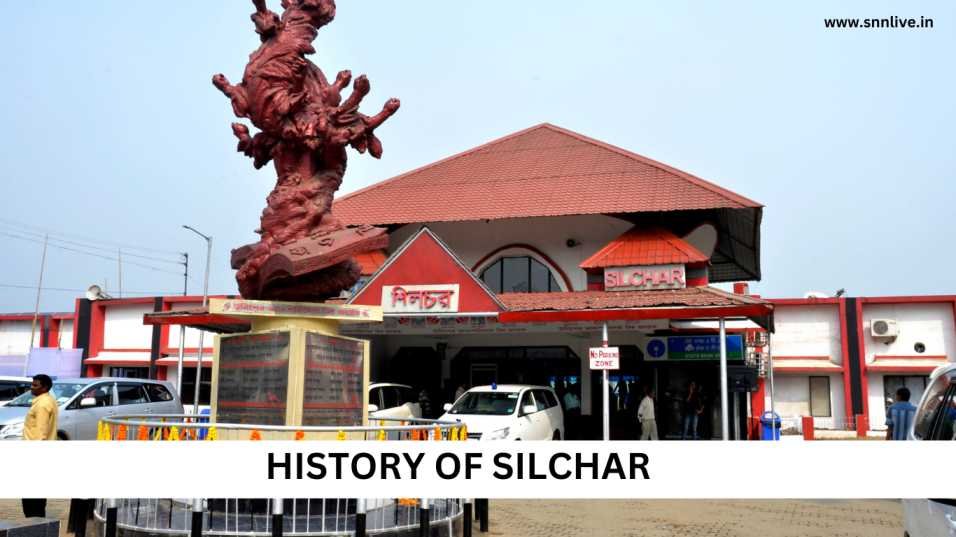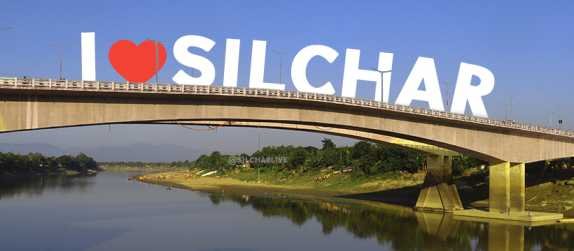History Of Silchar :
Silchar is a city of hearts and the headquarters of the Cachar district of the state of Assam. The second-largest city in the North Eastern Region after Guwahati in terms of area, population, and GDP. And it is also the administrative capital of the Barak Valley division. It was founded by Captain Thomas Fisher in 1832, when he shifted the headquarters of Cachar to Janiganj in Silchar. It earned the moniker “Island of Peace” from Indira Gandhi, the then Prime Minister of India. Silchar hosts the world’s inaugural polo club and witnessed the inception of the first competitive polo match. In 1985, a historic event occurred when an Air India flight from Kolkata to Silchar marked the world’s foremost all-women crew flight. Historically, Silchar has been recognised as a tea town.

Etymology :
The name Silchar comes from the two Sylheti words’shil’ and ‘char’, meaning ‘rock’ and’shore/island’, respectively. The city was founded in the Janiganj-Sadarghat area of the town, near the Barak Bank, which was used as a river port. It is theorised that the locals started calling the area ‘Shiler Chor’ meaning the rocky shore, which got shortened to ‘Silchar’, which was in turn adopted and popularised by the British.
Mediaeval History:
Cachar district, whose headquarters are in Silchar, was ruled by the Tippera dynasty in the 13th century. The kingdom originally established its capital in Khalangsha in Cachar, specifically identified as Rajghat village in Sonai, located 18 km from Silchar. Over time, the Tippera community gradually migrated eastward to the area that is now known as Tripura. During the 16th century, Cachar became integrated into the Tripura kingdom.
The Tippera kings continued their rule in Barak Valley till the mid-16th century, when commander Chilarai of the Koch dynasty defeated the king of Tripura in 1562 in Longai. The river Longai delineated the border between the Tripura and Koch kingdoms. Bir Chilarai, alternatively called Shukladhwaja, served as the younger sibling of Koch King Naranarayan. Another brother of Naranarayan was Gosai Kamal, also known as Kamal Narayan. Gosai Kamal was appointed as the governor of Barak Valley and governed the region from Khaspur, situated 20 km from Silchar.
Even after the collapse of the Koch kingdom elsewhere, the Kochs continued ruling Cachar from Khaspur. After Gosai Kamal, seven more Koch kings, namely Udita Singha, Dhir Singha, Mehendra Singha, Ranjit Singha, Nara Singha, and Bhim Singha, ruled the area. Bhim Singha, the final ruler of the Koch dynasty in Khaspur, had only a daughter named Kanchani. In 1745, she entered matrimony with Prince Laksmichandra from the Kachari Dimasa kingdom of Maibang. Maibang is in the present-day hill district of Dima Hasao, adjacent to Cachar. Appointed as the governor of a portion of the kingdom, Laksmichandra left a lasting legacy with the area still bearing his name: Lakhipur, located 25 km from Silchar. Following Bhim Singha’s demise, Laksmichandra ascended to the position of Raja, and, over time, he orchestrated the merger of the two kingdoms. This consolidation resulted in the current-day Cachar falling under Dimasa rule. During the reign of the Dimasa kings, Cachar experienced invasions from various quarters, including the Mughals, Jaintias, Manipuri kings, Burmese, and Ahoms.
Bengali presence in the Kachari Kingdom, While the hilly areas of the Kachari kingdom, i.e., Dima Hasao, had a Dimasa stronghold, the plain areas, i.e., present-day Cachar, had Bengalis constituting the majority. While Bengalis had been inhabiting Cachar before the Koch rule, the Dimasa kings encouraged increased migration of Bengalis from nearby areas as priests, cultivators, and ministers at court. Bengali Brahmins formally converted the Dimasa kings to Hinduism when Raja Krishna Chandra and Raja Govinda Chandra performed the Hiranyagarbha ceremony in 1790.
The kings, in reciprocation, actively supported Bengali literature. Bengali served as the official language in the court of the Kachari kings. They facilitated the translation of Sanskrit texts into Bengali and personally engaged in the composition of prose and poetry in the Bengali language. In fact, Raja Krishna Chandra and Raja Gobinda Chandra wrote the 27 letters to the East India Company, making them some of the only surviving written examples of the Bengali tradition in the late 18th and early 19th centuries.

Colonial History:
The Burmese Invasion and the Treaty of Badarpur, After taking over parts of the Brahmaputra Valley and Manipur by 1823, the Burmese made forays into Cachar as well. The then Governor General of India, Lord William Amherst, saw the British occupation of Cachar as essential to guarding the nearby British-held district of Sylhet from the Burmese. On March 6, 1824, Gobinda Chandra signed the Treaty of Badarpur with the British, who declared Cachar a British protectorate and recognised Raja Gobinda Chandra as the ruler of Cachar.
The Burmese army attacked Cachar in 1824, and the British declared war on them. Eventually, the two armies clashed in the Burmese stronghold of Dudpatil, 15 km from Silchar, and the British were able to drive the Burmese away to Manipur in 1825. The clash in Cachar was the start of the First Anglo-Burmese War, which ended with the Treaty of Yandabo, wherein the Kingdom of Ava agreed to stop attacking Cachar, amongst other areas. Gobinda Chandra was reinstated on the throne but had to pay an annual tribute of Rs. 10,000 to the British as per the Treaty of Badarpur, which adversely affected the post-Burmese occupation of Cachar’s economy.
On April 24, 1830, Gobinda Chandra met his demise without leaving any heirs. Although Gambhir Singh of Manipur, suspected to be the mastermind behind the assassination, asserted a claim to Cachar, the territory transitioned into British possession in accordance with the Treaty of Badarpur. Assuming control on June 30, 1830, Captain Thomas Fisher, an army officer, established headquarters in Cherrapunji. Formal British occupation of Cachar took place on August 14, 1832, and in 1833, Silchar became the designated headquarters. Cachar remained a part of the Bengal province from 1832 to 1874 when the district underwent transfer to the newly formed Assam province.
Foundation of Silchar:
There is no mention of any place called ‘Silchar’ before the annexation of Cachar. Gobinda Chandra’s dominion encompassed various regions, including Tarapur, Ambikapur, Kanakpur, and Rangpur, identified as villages. Interestingly, ‘Silchar’ did not feature among the listed areas under Gobinda Chandra. The earliest reference to Silchar dates back to 1835 in a report authored by R.B. Pamberton, and subsequent mentions of Silchar can be traced in British official documents. Established as the administrative centre of Cachar, Silchar originated in the Janiganj-Sadarghat area of the town. In 1832, Captain Fisher commenced the construction of Sadar Station in Janiganj after relocating the district headquarters to Silchar. Janiganj, previously a taluk under the Mirasdars of Ambikapur before being acquired by Gobinda Chandra, existed prior to British influence. Captain Thomas Fisher, in this context, is credited as the founder of Silchar. Presently, Janiganj still houses the Sadar Station and the District Court.
Silchar under the British:
Captain Fisher’s efforts led to the establishment of a medical centre in Silchar in 1835, eventually evolving into a hospital by 1864. The tea industry in Cachar was growing by 1855, which led to Silchar’s emergence as a centre of trade and commerce. In 1863, Reverend Pyrse founded the first English educational institution in the town, known as the High Grammar School. This institution later transformed into the Government Boys Higher Secondary School. Additionally, in 1864, the establishment of a charitable dispensary took place, eventually evolving into the Civil Hospital. Silchar got its very first body for self-governance. The Bengal Municipal Act, 1876, led to the establishment of a town committee in 1882. Establishing itself in 1876, Keating Library, the first library in Silchar, underwent a name change to Arun Chanda Granthagar after Independence. In 1891, the town became a municipality, and in 1899, the Assam-Bengal railways reached Silchar, providing easier access to the Chittagong sea port. Silchar was connected to Kolkata through steamers as well.
Silchar Polo Club:
In the 1850s, the British saw banished princes from Manipur playing Sagol Kangjei in Silchar. This game was the forerunner of modern polo, which was already liked in Manipur nearby. Captain Robert Stewart, then assistant deputy commissioner, participated in the game with the Manipuri players. In 1859, Stewart, who was the deputy commissioner, and Major General Joseph Sherer, the assistant deputy commissioner, started the first polo club in the world in Silchar. They named it the Silchar Kangjei Club.The Silchar Polo Club, later renamed the Cachar Club, still thrives today, although polo is no longer played. Silchar also witnessed the inception of the first competitive modern form of polo, and the plaque commemorating this achievement remains behind the local District Library.
Post-independence history:
After the Partition of Assam and the Independence of India, the town of Silchar saw a large increase of 10.5% in its population in the decade of 1941–51. This was largely because of the migration of Hindu refugees from the adjacent district of Sylhet to East Pakistan. The effect of the partition was felt administratively as well. The Sessions Court of Sylhet had a Circuit Court present in Silchar until independence. After that, Silchar and the rest of Cachar came under the District and Sessions Judge, Jorhat, till 1955, when the District and Sessions Judge of Cachar District took over in Silchar. S. K. Dutta became the first district and session judge of the Cachar District Judiciary.
Apart from the refugees from East Pakistan, Silchar also saw a lot of migration from neighbouring states in the Northeast due to political disturbances, which added to the population growth. The 1971 Bangladesh Liberation War saw more migration from East Pakistan.
Geography :
It is located between longitudes 92º24’ E and 93º15’ E and latitudes 24º22’N and 25º8’N East, and is 35 metres above mean sea level. Situated in a flat alluvial plain, the city’s landscape is characterised by swamps, streams, and occasional small hills referred to locally as “tilla.” In addition to the Barak River, another significant watercourse in the region is the Ghagra River.
Silchar is in Zone V on the Seismic Zonation Map and has witnessed major earthquakes. The earthquake in January 1869 was of magnitude 7.5 on the Richter scale and caused heavy damage.
Also Read : Top 10 places in Silchar ! Best Tourist Places
Upload your property : Ghordekho



